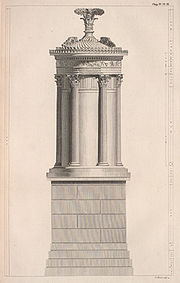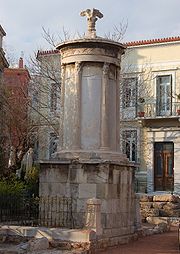
Choragic Monument of Lysicrates
Encyclopedia


Acropolis
Acropolis means "high city" in Greek, literally city on the extremity and is usually translated into English as Citadel . For purposes of defense, early people naturally chose elevated ground to build a new settlement, frequently a hill with precipitous sides...
of Athens
Athens
Athens , is the capital and largest city of Greece. Athens dominates the Attica region and is one of the world's oldest cities, as its recorded history spans around 3,400 years. Classical Athens was a powerful city-state...
was erected by the choregos
Choregos (ancient Greece)
In the theatre of ancient Greece, chorêgos was an honorary title for a wealthy Athenian citizen who assumed the public duty of financing and paying the expenses of the preparation of the chorus and other aspects of dramatic production that were not covered by the state...
Lysicrates, a wealthy patron of musical performances in the Theater of Dionysus to commemorate the award of first prize in 335/334 BCE, to one of the performances he had sponsored. The choregos was the sponsor who paid for and supervised the training of the dramatic dance-chorus
Greek chorus
A Greek chorus is a homogenous, non-individualised group of performers in the plays of classical Greece, who comment with a collective voice on the dramatic action....
.
History
The circular structure, raised on a high squared podium, is the first Greek monuments built in the Corinthian orderCorinthian order
The Corinthian order is one of the three principal classical orders of ancient Greek and Roman architecture. The other two are the Doric and Ionic. When classical architecture was revived during the Renaissance, two more orders were added to the canon, the Tuscan order and the Composite order...
on its exterior. It was originally crowned with an elaborate floral support for the bronze tripod that was the prize Lysicrates' chorus won. Its frieze sculptures depict episodes from the myth
Mythology
The term mythology can refer either to the study of myths, or to a body or collection of myths. As examples, comparative mythology is the study of connections between myths from different cultures, whereas Greek mythology is the body of myths from ancient Greece...
of Dionysus
Dionysus
Dionysus was the god of the grape harvest, winemaking and wine, of ritual madness and ecstasy in Greek mythology. His name in Linear B tablets shows he was worshipped from c. 1500—1100 BC by Mycenean Greeks: other traces of Dionysian-type cult have been found in ancient Minoan Crete...
, the god whose rites developed into Greek theatre. It stands now in its little garden on the Tripodon Street ("Street of the Tripods"), which follows the line of the ancient street of the name, which led to the Theater of Dionysus and was once lined with choragic monuments, of which foundations were discovered in excavations during the 1980s.
In 1658, a French
France
The French Republic , The French Republic , The French Republic , (commonly known as France , is a unitary semi-presidential republic in Western Europe with several overseas territories and islands located on other continents and in the Indian, Pacific, and Atlantic oceans. Metropolitan France...
Capuchin monastery
Order of Friars Minor Capuchin
The Order of Friars Minor Capuchin is an Order of friars in the Catholic Church, among the chief offshoots of the Franciscans. The worldwide head of the Order, called the Minister General, is currently Father Mauro Jöhri.-Origins :...
was founded by the site; in 1669 the monastery
Monastery
Monastery denotes the building, or complex of buildings, that houses a room reserved for prayer as well as the domestic quarters and workplace of monastics, whether monks or nuns, and whether living in community or alone .Monasteries may vary greatly in size – a small dwelling accommodating only...
succeeded in purchasing the monument
Monument
A monument is a type of structure either explicitly created to commemorate a person or important event or which has become important to a social group as a part of their remembrance of historic times or cultural heritage, or simply as an example of historic architecture...
, then being called the "Lantern of Demosthenes
Demosthenes
Demosthenes was a prominent Greek statesman and orator of ancient Athens. His orations constitute a significant expression of contemporary Athenian intellectual prowess and provide an insight into the politics and culture of ancient Greece during the 4th century BC. Demosthenes learned rhetoric by...
" after the famous Athenian statesman of the 4th c. BCE. A reading of its inscription by Jacob Spon established its original purpose. The young British architects James "Athenian" Stuart and Nicholas Revett
Nicholas Revett
Nicholas Revett was a Suffolk gentleman and amateur architect and artist.He is best known for his famous work with James Stuart documenting the ruins of ancient Athens. Its illustrations compose 5 folio volumes and include 368 etched and engraved plates, plans and maps drawn at scale...
published the first measured drawings of the monument in their Antiquities of Athens, London 1762. The monument became famous in France and England through engravings of it, and "improved" versions became eye-catching features in several English landscape garden
Landscape garden
The term landscape garden is often used to describe the English garden design style characteristic of the eighteenth century, that swept the Continent replacing the formal Renaissance garden and Garden à la française models. The work of Lancelot 'Capability' Brown is particularly influential.The...
s. Lord Byron stayed at the monastery during his second visit to Greece. In 1818, friar Francis planted in its gardens the first tomato
Tomato
The word "tomato" may refer to the plant or the edible, typically red, fruit which it bears. Originating in South America, the tomato was spread around the world following the Spanish colonization of the Americas, and its many varieties are now widely grown, often in greenhouses in cooler...
plants in Greece. In 1821 the convent, which had enclosed the monument, used as a storage for books, was burned during the Ottoman occupation of Athens, and subsequently demolished, and the monument was inadvertently exposed to the weather. In 1829, the monk
Monk
A monk is a person who practices religious asceticism, living either alone or with any number of monks, while always maintaining some degree of physical separation from those not sharing the same purpose...
s offered the structure to an Englishman on tour, but it proved to be too cumbersome to disassemble and ship. Lord Elgin negotiated unsuccessfully for the monument, by then an icon in the Greek Revival.
French archaeologists cleared the rubble from the half-buried monument and searched the area for missing architectural parts. In 1876–1887, the architects François Boulanger and E. Loviot supervised a restoration under the auspices of the French government.
Other versions
Famous British versions of the Choragic Monument include the Dugald Stewart MonumentDugald Stewart Monument
The Dugald Stewart Monument is a memorial to the Scottish philosopher Dugald Stewart . It is situated on top of Calton Hill, overlooking Edinburgh city centre....
in Edinburgh
Edinburgh
Edinburgh is the capital city of Scotland, the second largest city in Scotland, and the eighth most populous in the United Kingdom. The City of Edinburgh Council governs one of Scotland's 32 local government council areas. The council area includes urban Edinburgh and a rural area...
, on the tower of St Giles Church in Elgin and in the gardens at Shugborough, Staffordshire and Alton Towers
Alton Towers
Alton Towers is a theme park and resort located in Staffordshire, England. It attracts around 2.7 million visitors per year making it the most visited theme park in the United Kingdom. Alton Towers is also the 9th most visited theme park in Europe...
among many others. The Grade I-listed St John the Evangelist's Church, Chichester
St John the Evangelist's Church, Chichester
St John the Evangelist's Church is a former Anglican church in the cathedral city of Chichester in West Sussex, England. Built in 1812 to the design of James Elmes as a proprietary chapel, the octagonal white-brick "evangelical preaching house" reflects the early 19th-century ideals of the Church...
, now redundant
Redundant church
A redundant church is a church building that is no longer required for regular public worship. The phrase is particularly used to refer to former Anglican buildings in the United Kingdom, but may refer to any disused church building around the world...
, is topped with a "preposterous miniature" of the monument.
In the US, the Choragic Monument was William Strickland
William Strickland (architect)
William Strickland , was a noted architect in nineteenth-century Philadelphia, Pennsylvania and Nashville, Tennessee.-Life and career:...
's model for the cupola of the Merchants' Exchange
Merchants' Exchange Building (Philadelphia)
Built between 1832 and 1834, the Merchants' Exchange Building, is located on the triangular site bounded by Dock Street, Third Street, and Walnut Street. This monumental office building, designed by architect William Strickland, operated as a brokerage house in the nineteenth century...
in Philadelphia and copied by him for the cupola atop the Tennessee State Capitol
Tennessee State Capitol
The Tennessee State Capitol, located in Nashville, Tennessee, is the home of the Tennessee legislature, the location of the governor's office, and a National Historic Landmark. Designed by architect William Strickland, it is one of Nashville's most prominent examples of Greek Revival architecture...
building in Nashville. The design of the Portland Breakwater Light
Portland Breakwater Light
The Portland Breakwater Light is a small lighthouse in South Portland, Maine. The lighthouse's flashing red beacon helped guide ships from Casco Bay through the entrance to Portland Harbor.-History:...
in Maine was inspired by the monument. It was adapted for Civil War memorials and capped many Beaux-Arts towers, such as The San Remo
The San Remo
The San Remo is a luxury, 27-floor, co-operative apartment building in New York City located between 74th and 75th streets, about 1/10 of a mile north of the Dakota building The San Remo is described by Glen Justice of the New York Times as "a dazzling two-tower building with captivating views...
's towers in New York.
There is also a version in the Botanic Gardens in Sydney, New South Wales.

